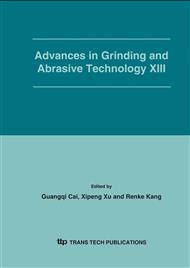p.156
p.161
p.166
p.171
p.176
p.181
p.186
p.191
p.196
A Fundamental Study on Optimal Oxide Layer of Fine Diamond Wheels during ELID Grinding Process
Abstract:
In ELID (Electrolytic In-process Dressing) operations, the setting of starting point is quite important for reducing waste of time and for achiving high quality surface. In this study, the authors proposed a new describing mode for ELID grinding. The oxide layer formed on the wheel surface was divided to four sub-layer: porous-layer, polishing-layer, grinding-layer and interface-layer. The influence of the oxide layer on material removal rates and surface properties was investigated. It was found that, olny the oxide layer with thickness less than 24'm has capability of material removal. In ELID grinding, optimal thickness of the oxide layer is about 8~9'm. And the oxide layer with thickness of 4~9'm is suitable for grinding.
Info:
Periodical:
Pages:
176-180
Citation:
Online since:
February 2006
Authors:
Price:
Сopyright:
© 2006 Trans Tech Publications Ltd. All Rights Reserved
Share:
Citation:


